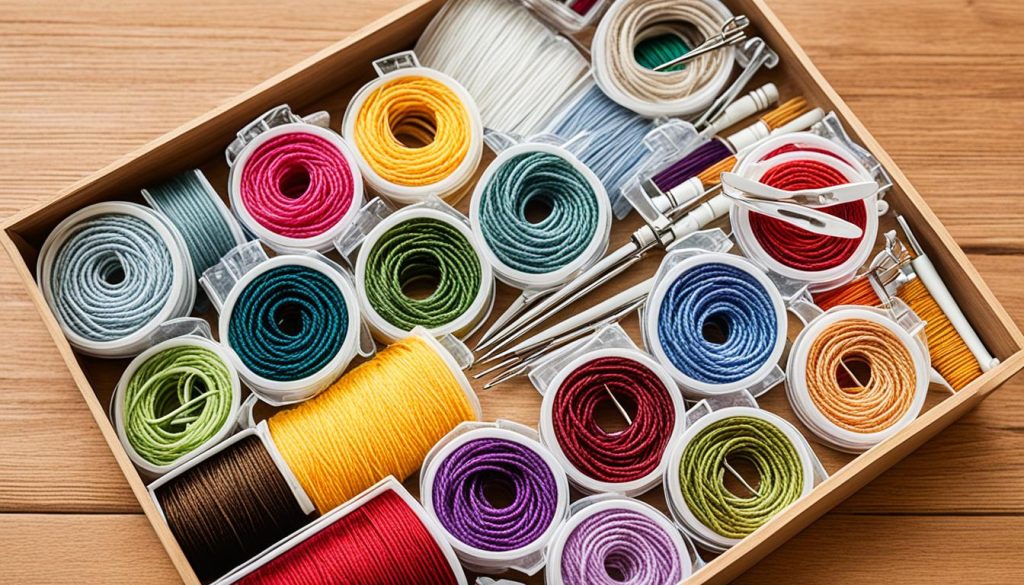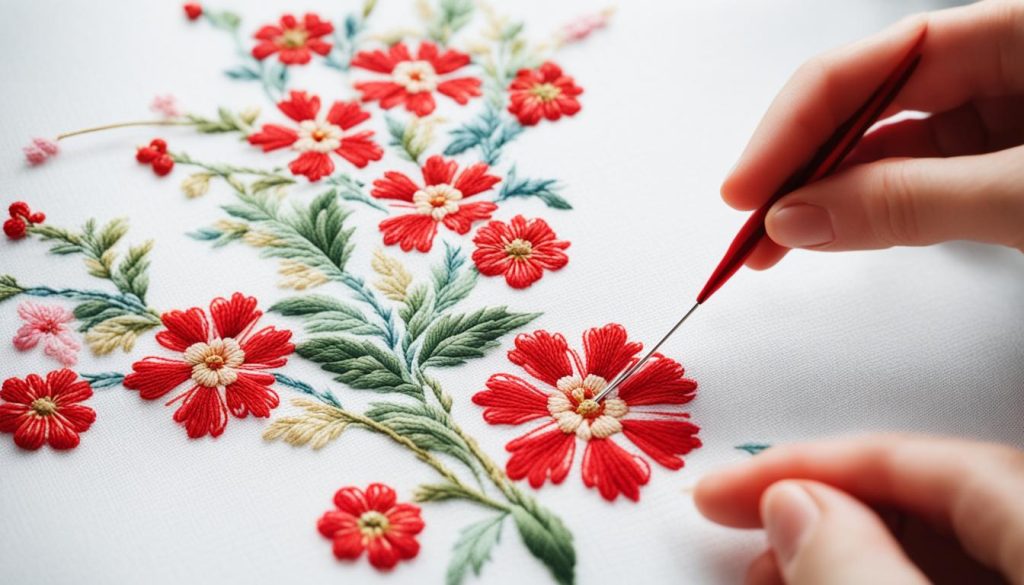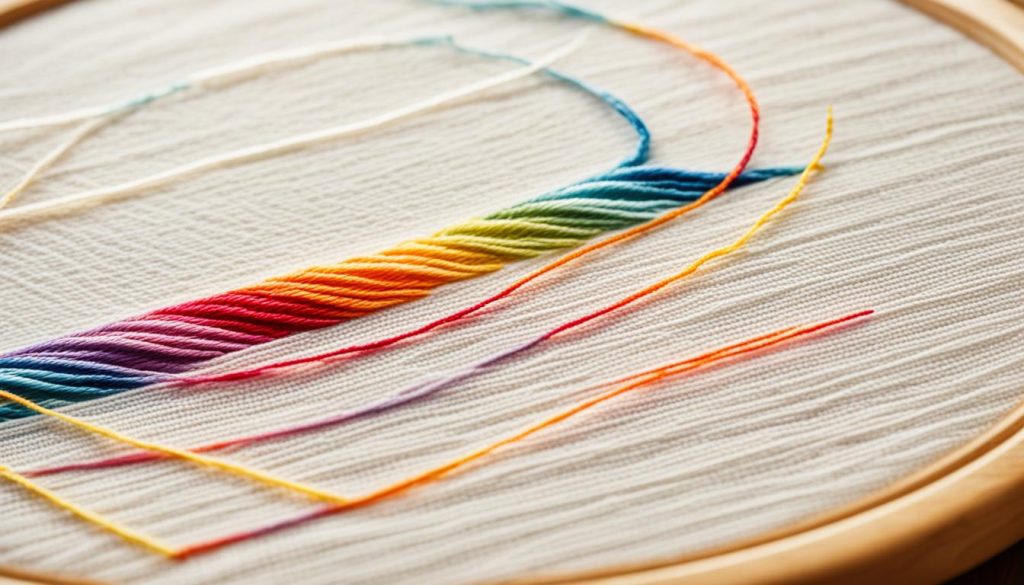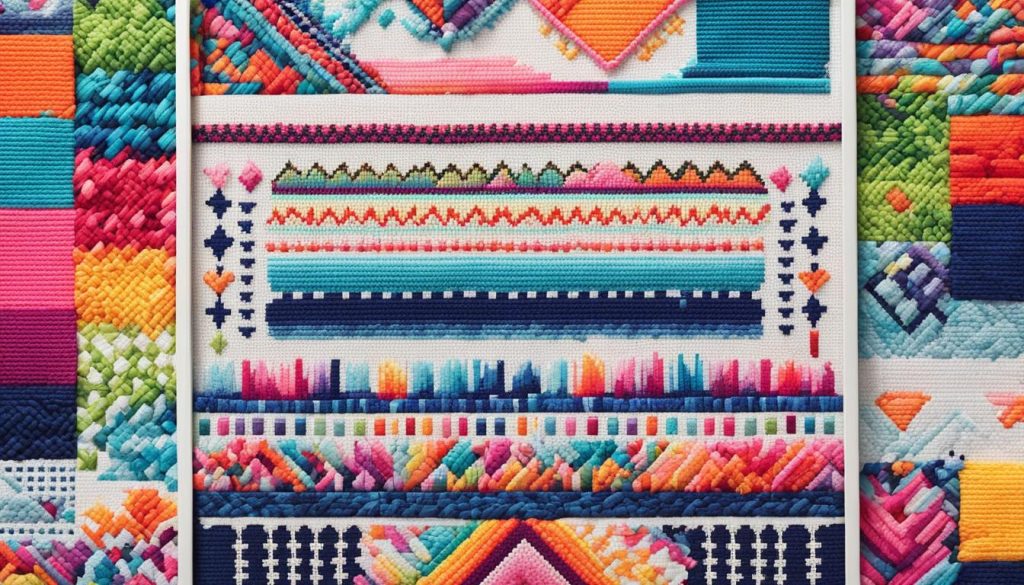Cross stitch has been around since almost 600 BC. It started in ancient Egyptian tombs and has changed a lot over time. The Tang Dynasty in China (618-906 AD) is known for some of the first crossstitching work.
In Europe, Catherine of Aragon made crossstitching popular in the 16th century. She was the first wife of Henry VIII. Her love for it made it more than just a way to decorate clothes. The printing press made crossstitching patterns easy to get, making it a big part of art and culture.
Looking into crossstitching history shows how it went from being a useful embroidery to a favorite hobby. The invention of aida cloth helped make crossstitching patterns more detailed. This brought it into the modern world, keeping its charm over the years.
Key Takeaways
- Cross stitch dates back to 600 BC, with ancient examples from Egyptian tombs.
- The Tang Dynasty in China showcases some of the earliest examples of crossstitching embroidery.
- Catherine of Aragon significantly influenced the popularity of crossstitching in Europe, especially through blackwork.
- The printing press enabled the widespread distribution of crossstitching patterns by the late 1600s.
- Aida cloth, invented in the late 1890s, boosted the creation of more intricate samplers.
- Modern crossstitching experienced notable resurgences in the 1960s and 1980s.
- Technological advances now allow enthusiasts to share crossstitching techniques and patterns online, fostering a global community.
Introduction to Cross Stitch
Explore the world of crossstitching, a beloved craft for beginners and experts alike. It’s a type of embroidery where you make X-shaped stitches on fabric. These stitches form beautiful pictures and patterns. Today, it’s popular for its easy-to-learn nature.
If you’re starting with beginner crossstitching, knowing the basics is key. Beginners often use Aida or linen fabric because they have a grid that helps with stitching. The fabric’s count, like 14-count Aida, tells you how many stitches fit in an inch. This affects the detail and size of your design.
For crossstitching supplies, you’ll need a few important items. You’ll need a pattern, fabric, embroidery floss, needles, and a hoop or frame. Optional tools like needle minders and magnifying glasses can make stitching easier. Remember to buy all your supplies at once to avoid color differences and keep your stitches even.

| Essential Supplies | Optional Tools |
|---|---|
| Embroidery hoop or frame | Needle minder |
| Needles | Threader |
| Aida or linen fabric | Clip-on light |
| Embroidery floss | Stitch scissors |
Cross stitch kits are great for beginners because they come with everything you need for a project. They make starting out easy. If you want to try something new, free crossstitching patterns are easy to find online. They let you create unique designs without spending more money.
When you begin, place your fabric in the center and start stitching from the middle of your design. This keeps your work balanced. Work in rows from left to right and handle the floss carefully to avoid tangles. Most importantly, enjoy making each stitch and watch your simple threads turn into beautiful art.
The Origins of Cross Stitch
Cross stitch embroidery has a long history tied to ancient civilizations. It started with early art forms using silk thread. Over time, crossstitching traveled across continents, changing and touching many cultures.
Tang Dynasty in China
In the Tang Dynasty (618-906 AD), Chinese crossstitching reached its peak. This period is famous for its detailed and lovely crossstitching patterns. Artists during this time turned cross stitch into a true art form.
The art of Chinese crossstitching spread through the Silk Road. This helped share culture and art between East and West.

Old Egyptian and medieval tombs show how important crossstitching has been for centuries. Its move from China to other areas shows its lasting impact on embroidery.
The Influence of Arab Civilization
In the Arab world, crossstitching grew even more. Blackwork, a type of embroidery with geometric patterns in black wool on linen, became big here. It was especially popular in Spain during the Moorish rule (756-1492 AD).
Catherine of Aragon made blackwork famous in England, where it became a key part of Tudor culture. Through her marriage, she brought blackwork to the English royalty. This made it a big part of English needlework.
Today, the early crossstitching work still inspires many hobbyists. The art and culture from ancient times are still seen in today’s cross stitch. This shows its lasting beauty and craftsmanship.
European Influence and Popularization
Catherine of Aragon made European crossstitching very popular. She brought blackwork embroidery to England. This style uses only one color and became a favorite in Europe.
Catherine of Aragon and Blackwork
Catherine of Aragon came from Spain and married into the English royal family. She introduced blackwork embroidery, known for its detailed geometric patterns on white linen. This style quickly became a key part of European crossstitching.

Blackwork embroidery’s popularity helped grow other crossstitching techniques across Europe. Cross stitch samplers became important for learning. They included alphabets, numbers, and patterns for practice and decoration.
The Printing Press and Pattern Books
The printing press in the 15th century changed crossstitching. It made pattern books easier to get. This let more people try out different designs.
With pattern books available, embroiderers could explore many designs. This led to more creativity and innovation. Cross stitch samplers became popular, showing off skills in sewing and reading.
| Key Development | Impact on Cross Stitch |
|---|---|
| Introduction of Blackwork Embroidery by Catherine of Aragon | Popularized monochromatic geometric patterns in Europe |
| Spread of the Printing Press | Mass production of crossstitching charts and pattern books |
| Creation of Cross Stitch Samplers | Combined education and craftsmanship |
Modern Cross Stitch Renaissance
The modern cross stitch has seen a big comeback, especially in the 1960s and 1980s. These times brought new life to the craft, adding modern themes and more materials and patterns. This led to the creation of special crossstitching kits and the rise of stamped crossstitching in today’s designs.
The Resurgence in the 1960s and 1980s
In the 1960s, cross stitch became a popular hobby again. This era brought back traditional patterns and added new ones. The 1980s made crossstitching even more popular, thanks to more resources and patterns.
This time was full of different designs and a big interest in personalized kits and stamped cross stitch. The shift from old samplers to new patterns was clear during these decades.
Technological Advances
Technology has changed crossstitching a lot. Now, you can easily find modern crossstitching designs online. Cross stitch software and apps let hobbyists make their own designs easily.
Online, Cross stitch YouTube channels share tutorials, and Cross stitch online shops have lots of supplies. These changes have made crossstitching more popular and reached more people. Also, crossstitching software helps turn complex images into easy patterns, making creativity easier.
Cross Stitch in Contemporary Culture
Cross stitch is evolving, blending traditional craftsmanship with a modern twist. This mix has led to new designs that are both nostalgic and bold. These designs reflect today’s social themes with humor and critique.

Postmodern and Subversive Designs
Artists like Ana Martins, known as Aheneah, turn traditional crossstitching into urban graffiti. Lithuanian artist Severija Incirauskaite-Kriauneviciene stitches on found objects, adding a new layer of meaning. Her work challenges traditional cross stitch and sends deeper messages.
These designs stand out with their bold colors, unlike traditional patterns. Geometric and abstract patterns are now popular, offering a fresh take on the craft. They often include inspirational quotes and humor, making crossstitching more appealing to a younger crowd.
Cross Stitch Communities and Guilds
The comeback of crossstitching has led to the growth of global communities and guilds. These groups help stitchers connect and work together. Social media sites like Instagram, Facebook, and Reddit are now key places for sharing and discussing cross stitch.
Workshops, retreats, and charity events bring stitchers together. They offer a chance to learn new skills and support good causes. Cross stitch welcomes everyone, from beginners to experts, into its community.
| Key Figure | Contribution | Style |
|---|---|---|
| Jordan Nassar | Uses Palestinian cross stitch (tatreez) to connect with heritage | Traditional and Cultural |
| Ana Martins (Aheneah) | Urban cross stitch graffiti deconstructing traditional forms | Postmodern and Graphic |
| Severija Incirauskaite-Kriauneviciene | Stitches on found objects, subverting traditional practices | Subversive and Conceptual |
| Nils Viga Hausken | Incorporates Nordic cross stitch traditions into modern designs | Modern and Nordic |
Conclusion
Cross stitch has a long history filled with cultural diversity. It started in the Tang Dynasty in China and spread to Europe. Figures like Catherine of Aragon and the printing press helped make it popular in Europe.
Today, crossstitching has seen a big comeback, especially in the 1960s and 1980s. New technology made it easier to create and share designs. The internet has brought people together, sharing patterns and ideas.
Now, crossstitching is more than just a hobby. It’s a way to express creativity and reflect on society. With its place on the UNESCO List, it’s clear crossstitching is important to our culture.
John Lewis and Hobbycraft have seen a big rise in sales, showing it’s popular with the young and even men. Cross stitch lets you make unique gifts and explore new patterns and materials. It’s a great way to be creative and relax.
